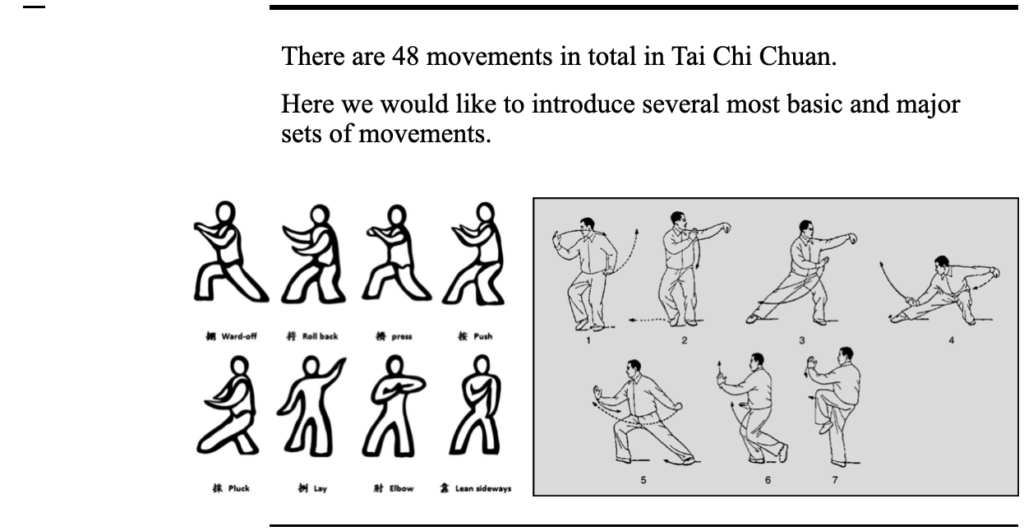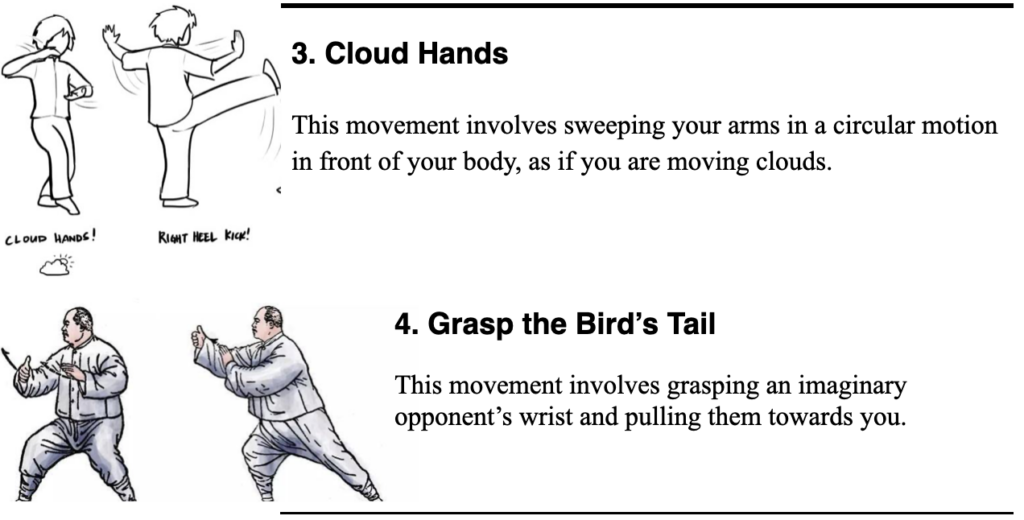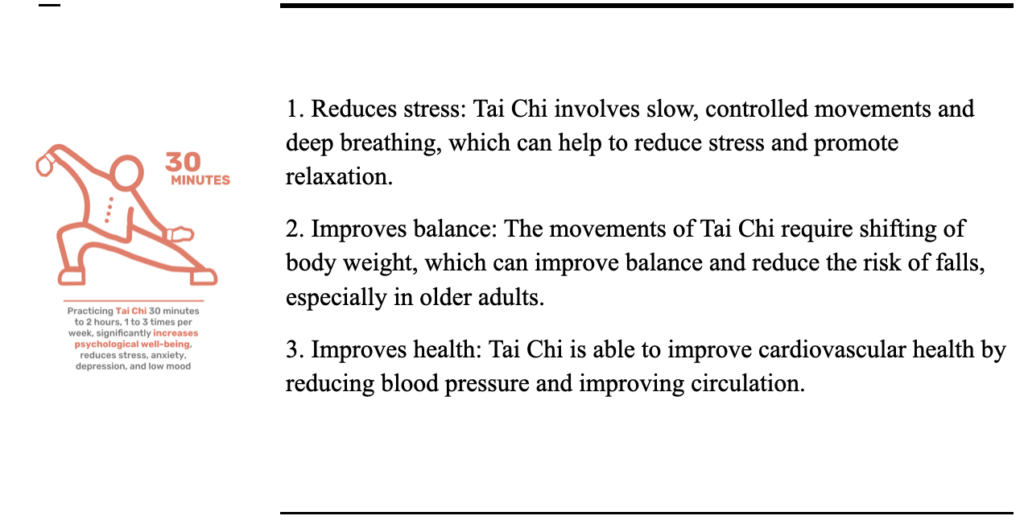EDCI 337: Multimedia Design Group Project
By: Stella Yan, Cyan Liu, Junze Bian, Jacky Li, Guanhua Wang
This course is for all those who are interested in Tai Chi
Overview
Tai Chi, as a Chinese intangible cultural heritage, carries the inheritance and development of martial arts culture and is fundamental to the development of modern martial arts.
This week we will learn about:
- The origin and history of Tai Chi
- Tai Chi movements
- The benefits of Tai Chi
Our top priority is to teach the learners the basic Tai Chi moves,and we will help learners to learn Tai Chi better through videos, games, PowerPoint and final assignment.
Lesson Objectives
By the end of this class, you will be able to:
- Can perform some basic movements of Tai chi independently.
- The theoretical knowledge of Tai Chi and the history of Tai Chi.
- Understand the benefits of Tai Chi for people.
- When see one of the movements, will be able to think of which one it is, or rather know it is Tai Chi.
| Big Idea | Tai Chi is one of the traditional Chinese activities, an exercise that is good for physical and mental health, and learning Tai Chi will bring many benefits. |
| Learning Outcomes | At the end of the course, learners will be able to understand the historical story of Tai Chi, know the benefits of Tai Chi and learn the basic Tai Chi movements. |
| Evidence of Learning | Students will successfully complete the activities and quizzes in the course and will be able to do basic Tai Chi independently in their daily lives. |
| Assessments | Students will complete a self-assessment by completing activities, quizzes set in the course. And a video of doing Tai Chi will be shown at the final assessment. |
| Learning Activities | Watch/read videos, articles, and web pages. Participate in interactive games and quizzes in the course. Complete at least one of the Reflection Questions. |
Warm Up Quiz
Read/Watch
It is a great idea to have a comprehensive understanding of Tai Chi before the class. Please take three minutes to get a general idea about Tai Chi.
Here is a performance of Tai Chi, hoping that you will become more interested and passionate about Tai Chi.
Content
Let’s officially begin our journey of learning Tai Chi. Trust me, it will be very interesting~
The Origin of Tai Chi

Movements of Tai Chi



Instructional Video
This instructional video is personally demonstrated by our team member
——Teacher Bian.
A round of applause is truly deserved here!!!
Help you remember
Simple little game, find the same two cards
Advantages of Tai Chi

Pop quiz
Single-choice question
Application
By learning Taichi, learners can:
- Practice their posture, unblock their meridians, and give themselves a better temperament
- If there is a physical discomfort, learning Tai Chi can improve the learner’s health problems.
- improvements to breathing, challenges to the skeletal muscles, improvements to the digestive system, and a purifying effect on the brain
- When the learner is feeling irritable, they can adjust their mood through Tai Chi.
Reflection
- As a bginner in Tai Chi, would the learners think that Tai Chi would be boring compared to aerobic or anaerobic workouts?
- Can Tai Chi provide a certain amount of help to learner’s life?
- Would learning Tai Chi be an impossible task for impatient people?
- Can Tai Chi really be able to improve cardiovascular health?
- If you are a Tai Chi enthusiast, how long do you think it takes you to go from a novice to an experienced person?
To Do This Week
Here’s a to-do list that could help scaffold learners and reduce extraneous cognitive load when learning Tai Chi:
Tai Chi is a patient and persistent exercise that may take some time to remember the forms and develop proper alignment and smoothness of movement. While it may take some time to learn initially, Tai Chi is a gentle and easily understandable practice that most people can learn with patience and practice.
Mayer
Mayer’s principles used in our courses ( Debell, 2019):
We follow Meyer’s Coherence Principle: people learn best when irrelevant material is not included. In our courses, we make sure that all learning materials are helpful to students, and in the process of creating videos, we make sure to cut out the extras and use only the information that learners need. to ensure text and visuals that are directly related to the learning topic.
Next is the Signaling principle, meaning that they learn best when exactly what to look for is shown on the screen. We created the PowerPoint portion of the course to ensure that the important knowledge could be visualized for the students.
For the Redundancy Principle, this principle suggests that one should ideally not put narration, graphics and text together. If you already have narration and graphics, then the text above is just redundant information. However, during the video production of our course, we minimized the text in order to make the teaching of Tai Chi more detailed as well as to give the learners a clearer understanding of the Tai Chi movements when we had video and narration.
The Spatial Contiguity Principle refers to the fact that people learn best when there is close proximity between text and visuals on the screen. This principle we use for the PowerPoint in Content.
For the Temporal Contiguity Principle, during the production of the video, we made sure that our visuals and the voiceover audio were present at the same time.
In Multimedia Principle, people learn most effectively from words and pictures, not just words. That’s why we have added relevant pictures to the course content in addition to text.
In the video production, all narration voices were recorded by us personally, in line with the Voice Principle.
In addition, in the content, we used H5p to make interactive games and quiz as a course design to increase the fun and learning experience of the learners.
Instructional Design Model:
In designing the course, we used the constructive alignment model to guide students in integrating classroom activities and allowing them to learn through various activities and games. Before the course begins, we inform students of the objectives of the course, the format of the assessment, and the activities that students will need to participate in.
We also used the backwards design model to first identify expected learning goals to ensure students knew what they needed to do during the semester, then create assessments to measure student learning, and finally plan activities and lessons around the goals and assessments that would contribute to student success.
References
Taiji Champion Yang Shunhong – Honor of Kings Performance Part 1. (2022). YouTube. Retrieved from https://youtu.be/SkuYjeO7hTI.
What Is Tai Chi? Finally explained! (2020). YouTube. Retrieved from https://youtu.be/7McCi0z7FU8.
Lam, P. (2018, April 13). History of Tai Chi. Tai Chi for Health Institute. Retrieved April 6, 2023, from https://taichiforhealthinstitute.org/history-of-tai-chi-2/
Debell A, (2019), How to use Mayer’s 12 Principles of Multimedia [Examples Included], Water bear, Retrieved from: https://waterbearlearning.com/mayers-principles-multimedia-learning/
Kwan, M. J., Kwan, M. J., says:, S. T. E. F. F. E. R. N. hamilton, & says:, S. F. (2014, October 7). Planing lesson. fix it with shading. Retrieved April 6, 2023, from https://fixitwithshading.com/2014/03/12/planing-lesson/
Grand master Chang San-Feng. (n.d.). Retrieved April 6, 2023, from http://www.shaolintemplemi.org/grand-master-chang-san-feng.html
Attachment:
Leave a Reply
You must be logged in to post a comment.